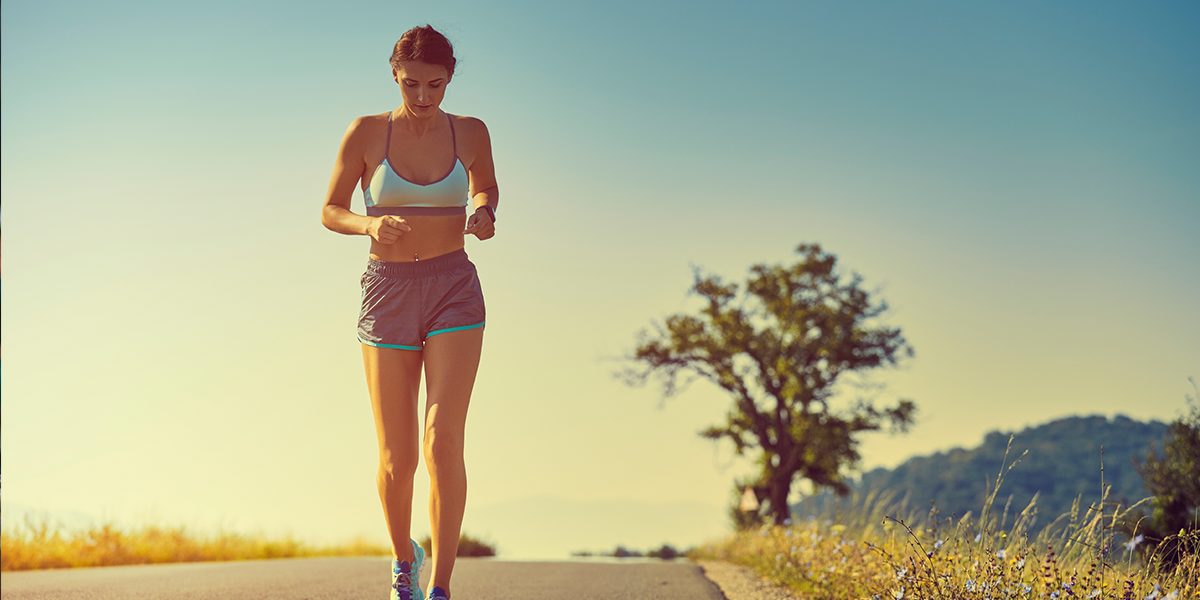When we decide to become healthier, lose weight, or simply take better care of ourselves, there is usually a specific reason, a desired outcome, driving that decision. But what gets you to start taking better care of yourself is often not what keeps you motivated day in and day out.
While future outcomes may be powerful enough to motivate great big intentions and investments of cash, research suggests that they may not be adequate to drive sustainable behavior.
This blog showcases 4 steps to move from merely changing behavior to sustaining it over time. These ideas are relevant for individuals, clinicians/practitioners, employers, and any type of health and wellness service provider.
I want to give you a heads up that this is a long post. For those who are interested in this topic, I thought it would be easier to read this content as one long post instead of many short ones.
Step #1 Close the Gap between Starting and Sustaining
Many people pledge (and really hope) to change their behavior. Common motivators include:
- their company offers a wellness challenge
- your doctor tells you that you need more sleep
- in the checkout line you see that magazine cover
- it’s New Year’s resolution time
To create lasting behavior change, we must understand that, in general, behavior doesn’t occur in a vacuum. Instead people decide to change their behavior because they hope it will help them achieve a specific outcome or goal. We adopt a new behavior because we believe it serves a specific function, or purpose, in our lives. In the health domain, people often change their behavior to achieve future outcomes like losing weight, decreasing bad cholesterol, or preventing diabetes.
These desired outcomes reflect the logical thinking that has been driving behavior-change initiatives for the last 30+ years. Yet, those large future outcomes mentioned above that spur us to change our behavior may also be the cause of its ultimate demise.
Given that sustainability is our ultimate goal, how do we bridge the gap between behavior change and behavioral sustainability? The answer might surprise you. New research suggests that large future outcomes, like disease prevention, might be too logical and not emotional enough.
Trending: Navy SEAL Secrets for High Performance Under Pressure
Step #2 Focus on Feelings Instead of Function
In my keynote for the National Business Group on Health last May (Rebranding Health as Well-being: A Better “Hook” to Motivate Sustainable Behavior and Create Thriving Organizations), I explained the important research about the links between health behavior and our brains. Basically, humans have two different (and often conflicting) systems that process information and drive our decisions and behavior. One system uses logic while the other system uses emotion. The logic-based system is vulnerable to depletion while the emotion-focused system actually motivates us effortlessly, often outside of our awareness. (If you want a very friendly read about these two systems, see the Heath brother’s book “Switch: How to Change Things When Change Is Hard”.)
While the two systems co-exist, one of them might be more central to sustaining healthy lifestyles over time. Research recently published in the Journal of Consumer Research (“Affect as a Decision-Making System of the Present”) investigated whether people rely more on their feelings about an outcome from a choice (e.g., How do I feel about exercising at the gym?) than the function of that outcome in their actual decision making (e.g., What do I hope to achieve from exercising?).
This study showed that when the outcomes from a choice occur close to the time of making the choice, participants relied more on their feelings. Thus, when the outcome of a decision happens close to the point of decision, our feelings about the outcomes drive our decisions more than the value of the outcome.
I’m going to suggest that all parties can become more successful closing the gap between behavior change and behavioral sustainability by shifting the frame of reference from the future outcomes from “behavior” (better health, weight loss, etc.) to the smaller outcomes that result from the “point of decision” (less stress, feeling proud of yourself, etc.)
Step #3 Target Daily Decisions Not Behavior
While the study I briefly described above was not focused on health-related behavior, it supports my experience from the last twenty years of helping people create sustainable behavior changes. This research has crucial implications about how all of us can better foster the consistent decision making that undergirds long-term fitness, health, and well-being.
The typical outcomes sought by people, professionals, and organizations from health-focused behavior changes are almost cliché, goals like weight loss, disease prevention, etc. It’s easy for us all to say (and really believe) that we value these important outcomes from self-care practices and health-behavior. Yet it’s another matter entirely to consistently prioritize a behavior with a function targeting the future, when everyone is constantly juggling many responsibilities and urgent fires related to the many aspects of our lives.
Our modern quick-paced society necessitates living with our attention in the present. Our hectic schedules do not permit many people the luxury of having their attention toward the future and desired aspirations. In this hectic context, much of our behavior, including the goals we pursue, occurs automatically, outside of our conscious awareness.
A key point is that this automatic system makes decisions out of our emotions and feelings about the choice at hand. Therefore, to more effectively motivate sustainable behavior we must shift our focus away from function of behavior to the feelings people have about the outcomes of health-related decisions.
Trending: How to Make Menopause the Best Time of Your Life
Let’s consider the specific decisions we have to make again and again that determine whether we sustain our well-intended self-care behaviors (physical activity, sufficient sleep, etc.):
- Leaving for exercise class or not
- Deciding which snack option to select in the refrigerator when hungry
At each point of decision, there are immediate outcomes about which we have some type of feeling.
- Do we have positives or negative feelings about the exercise class that is starting in 20 minutes?
- Does choosing carrots instead of chips have negative feelings associated with it because this decision feels like a chore we should do instead of a “gift” to ourselves?
For example, how someone feels about leaving their friends on Facebook compared to their feelings about going to sleep may drive their decision at 11:45pm about whether to sign off or stay on.
Generalizing from the “Affect as a Decision-Making System of the Present” study mentioned above, when our decision about something impacts us in the near future, how we feel about the different options (i.e., “participating in exercise class” vs. “not exercising”) is more likely to determine our choice in the moment than the future function, or value, of that choice (losing 30 pounds, preventing heart disease, pleasing someone, etc.).
Thus, to bridge the gap from behavior change to behavioral sustainability we must change our emphasis. Instead of focusing on the logic-based, future outcomes people seek from behavior change, we should understand and influence the feelings about the outcomes of every health-related decision.
New York Times columnist Jane Brody’s “Changing Our Tune on Exercise” column beautifully illustrates this need. Her thoughtful article about sustainable physical activity sheds light on the greater influence of feelings over function in driving health-related decision-making. Reflecting on her own experiences, Brody wrote that if you ask her why she exercises, “weight control may be my first answer, followed by a desire to live long and well. But that’s not what gets me out of bed before dawn to join friends on a morning walk … It’s how these activities make me feel: more energized, less stressed, more productive, more engaged and, yes, happier—better able to smell the roses and cope with the inevitable frustrations of daily life.”
Brody’s personal insights showcase the powerful role that feelings play in driving the repeated decision making that undergirds behavioral sustainability.
Whether we are individuals who want to adopt self-care behavior (e.g., exercise), practitioners who coach people in these issues, or organizations whose economic well-being depends on their employees’ good health we must turn our attention to creating positive feelings about the immediate outcomes of health-related decisions and self-care rather than their logic-based future function. How do you make this change? See the next section.
Step #4 Transform Self-Care from a Chore into a Gift
Trending: Microsoft, Google, and Beyond: What Business at the Cutting-Edge of AI Looks Like
When I first got into this area back in 1993, my guiding question was: “What is everything that undermines sustainable behavior and how can these things be prevented or overcome?”
In my long-term study of this issue, I discovered that one of the essential keys to cracking the code was to transform decisions about fostering self-care and health from negative to positive. My solution converts the meaning of a behavior and behavioral choice from feeling like a “chore to accomplish” into a “gift one wants to give themselves.”
After refining this process over two decades working with clients, I’ve found that this conversion is systematic and can be achieved quickly. Only days after teaching this approach in my behavioral sustainability trainings, practitioners send me excited emails sharing the powerful shifts they are getting with their patients from using my method to transform self-care from a chore into a gift. (Read their comments here.)
If you’d like to convert a behavior from a “chore” into a “gift” in your own life or for your professional work, the point of entry is understanding the primary reason, or what I call “The Why,” for initiating a behavior. Seek to understand whether the primary “Why” focuses on long-term goals that feel like “shoulds” or the immediate rewards from selecting the choices that favor self-care and well-being (e.g., more energy, etc.).
Research suggests that the “Why” for initiating behavior actually determines our relationship with the behavior, and whether it feels like a chore or a gift. Whether a behavior feels like a chore or a gift and determines how people feel about the in-the-moment decisions about self-care, and ultimately, whether the behavior is discontinued or sustained.
I call these two cycles, The Vicious Cycle of Failure and The Sustainable Cycle of Success, respectively. See the images below showcasing these two distinct cycles.

 I have written about this process, in a previous blog post about how to change the meaning of behavior from a chore into a gift. This “chore-to-gift” post is the last part of a three-part blog series called The Secret Life of Motivation. (To read this series in order see: Part I, Part II and Part III.)
I have written about this process, in a previous blog post about how to change the meaning of behavior from a chore into a gift. This “chore-to-gift” post is the last part of a three-part blog series called The Secret Life of Motivation. (To read this series in order see: Part I, Part II and Part III.)
In addition, if you want to read a personal account of someone who learned how to tip the scale from function to feeling and transformed exercise from a chore into a gift, check out this article in ELLE Magazine.






























